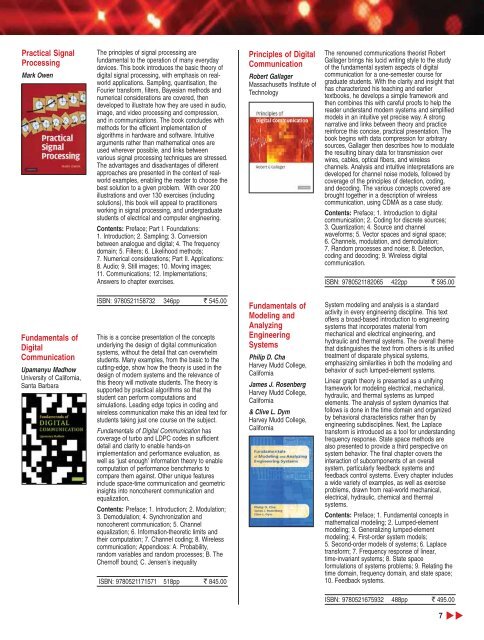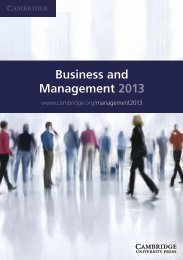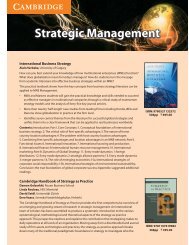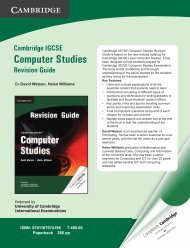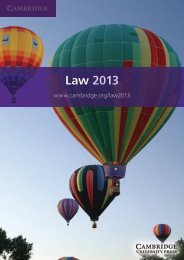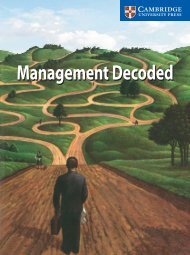ENGINEERING - Cambridge University Press India
ENGINEERING - Cambridge University Press India
ENGINEERING - Cambridge University Press India
Create successful ePaper yourself
Turn your PDF publications into a flip-book with our unique Google optimized e-Paper software.
Practical Signal<br />
Processing<br />
Mark Owen<br />
The principles of signal processing are<br />
fundamental to the operation of many everyday<br />
devices. This book introduces the basic theory of<br />
digital signal processing, with emphasis on realworld<br />
applications. Sampling, quantisation, the<br />
Fourier transform, filters, Bayesian methods and<br />
numerical considerations are covered, then<br />
developed to illustrate how they are used in audio,<br />
image, and video processing and compression,<br />
and in communications. The book concludes with<br />
methods for the efficient implementation of<br />
algorithms in hardware and software. Intuitive<br />
arguments rather than mathematical ones are<br />
used wherever possible, and links between<br />
various signal processing techniques are stressed.<br />
The advantages and disadvantages of different<br />
approaches are presented in the context of realworld<br />
examples, enabling the reader to choose the<br />
best solution to a given problem. With over 200<br />
illustrations and over 130 exercises (including<br />
solutions), this book will appeal to practitioners<br />
working in signal processing, and undergraduate<br />
students of electrical and computer engineering.<br />
Contents: Preface; Part I. Foundations:<br />
1. Introduction; 2. Sampling; 3. Conversion<br />
between analogue and digital; 4. The frequency<br />
domain; 5. Filters; 6. Likelihood methods;<br />
7. Numerical considerations; Part II. Applications:<br />
8. Audio; 9. Still images; 10. Moving images;<br />
11. Communications; 12. Implementations;<br />
Answers to chapter exercises.<br />
Principles of Digital<br />
Communication<br />
Robert Gallager<br />
Massachusetts Institute of<br />
Technology<br />
The renowned communications theorist Robert<br />
Gallager brings his lucid writing style to the study<br />
of the fundamental system aspects of digital<br />
communication for a one-semester course for<br />
graduate students. With the clarity and insight that<br />
has characterized his teaching and earlier<br />
textbooks, he develops a simple framework and<br />
then combines this with careful proofs to help the<br />
reader understand modern systems and simplified<br />
models in an intuitive yet precise way. A strong<br />
narrative and links between theory and practice<br />
reinforce this concise, practical presentation. The<br />
book begins with data compression for arbitrary<br />
sources, Gallager then describes how to modulate<br />
the resulting binary data for transmission over<br />
wires, cables, optical fibers, and wireless<br />
channels. Analysis and intuitive interpretations are<br />
developed for channel noise models, followed by<br />
coverage of the principles of detection, coding,<br />
and decoding. The various concepts covered are<br />
brought together in a description of wireless<br />
communication, using CDMA as a case study.<br />
Contents: Preface; 1. Introduction to digital<br />
communication; 2. Coding for discrete sources;<br />
3. Quantization; 4. Source and channel<br />
waveforms; 5. Vector spaces and signal space;<br />
6. Channels, modulation, and demodulation;<br />
7. Random processes and noise; 8. Detection,<br />
coding and decoding; 9. Wireless digital<br />
communication.<br />
ISBN: 9780521182065 422pp ` 595.00<br />
Fundamentals of<br />
Digital<br />
Communication<br />
Upamanyu Madhow<br />
<strong>University</strong> of California,<br />
Santa Barbara<br />
ISBN: 9780521158732 346pp ` 545.00<br />
This is a concise presentation of the concepts<br />
underlying the design of digital communication<br />
systems, without the detail that can overwhelm<br />
students. Many examples, from the basic to the<br />
cutting-edge, show how the theory is used in the<br />
design of modern systems and the relevance of<br />
this theory will motivate students. The theory is<br />
supported by practical algorithms so that the<br />
student can perform computations and<br />
simulations. Leading edge topics in coding and<br />
wireless communication make this an ideal text for<br />
students taking just one course on the subject.<br />
Fundamentals of Digital Communication has<br />
coverage of turbo and LDPC codes in sufficient<br />
detail and clarity to enable hands-on<br />
implementation and performance evaluation, as<br />
well as ‘just enough’ information theory to enable<br />
computation of performance benchmarks to<br />
compare them against. Other unique features<br />
include space-time communication and geometric<br />
insights into noncoherent communication and<br />
equalization.<br />
Contents: Preface; 1. Introduction; 2. Modulation;<br />
3. Demodulation; 4. Synchronization and<br />
noncoherent communication; 5. Channel<br />
equalization; 6. Information-theoretic limits and<br />
their computation; 7. Channel coding; 8. Wireless<br />
communication; Appendices: A. Probability,<br />
random variables and random processes; B. The<br />
Chernoff bound; C. Jensen’s inequality<br />
ISBN: 9780521171571 518pp ` 845.00<br />
Fundamentals of<br />
Modeling and<br />
Analyzing<br />
Engineering<br />
Systems<br />
Philip D. Cha<br />
Harvey Mudd College,<br />
California<br />
James J. Rosenberg<br />
Harvey Mudd College,<br />
California<br />
& Clive L. Dym<br />
Harvey Mudd College,<br />
California<br />
System modeling and analysis is a standard<br />
activity in every engineering discipline. This text<br />
offers a broad-based introduction to engineering<br />
systems that incorporates material from<br />
mechanical and electrical engineering, and<br />
hydraulic and thermal systems. The overall theme<br />
that distinguishes the text from others is its unified<br />
treatment of disparate physical systems,<br />
emphasizing similarities in both the modeling and<br />
behavior of such lumped-element systems.<br />
Linear graph theory is presented as a unifying<br />
framework for modeling electrical, mechanical,<br />
hydraulic, and thermal systems as lumped<br />
elements. The analysis of system dynamics that<br />
follows is done in the time domain and organized<br />
by behavioral characteristics rather than by<br />
engineering subdisciplines. Next, the Laplace<br />
transform is introduced as a tool for understanding<br />
frequency response. State space methods are<br />
also presented to provide a third perspective on<br />
system behavior. The final chapter covers the<br />
interaction of subcomponents of an overall<br />
system, particularly feedback systems and<br />
feedback control systems. Every chapter includes<br />
a wide variety of examples, as well as exercise<br />
problems, drawn from real-world mechanical,<br />
electrical, hydraulic, chemical and thermal<br />
systems.<br />
Contents: Preface; 1. Fundamental concepts in<br />
mathematical modeling; 2. Lumped-element<br />
modeling; 3. Generalizing lumped-element<br />
modeling; 4. First-order system models;<br />
5. Second-order models of systems; 6. Laplace<br />
transform; 7. Frequency response of linear,<br />
time-invariant systems; 8. State space<br />
formulations of systems problems; 9. Relating the<br />
time domain, frequency domain, and state space;<br />
10. Feedback systems.<br />
ISBN: 9780521675932 488pp ` 495.00<br />
7


